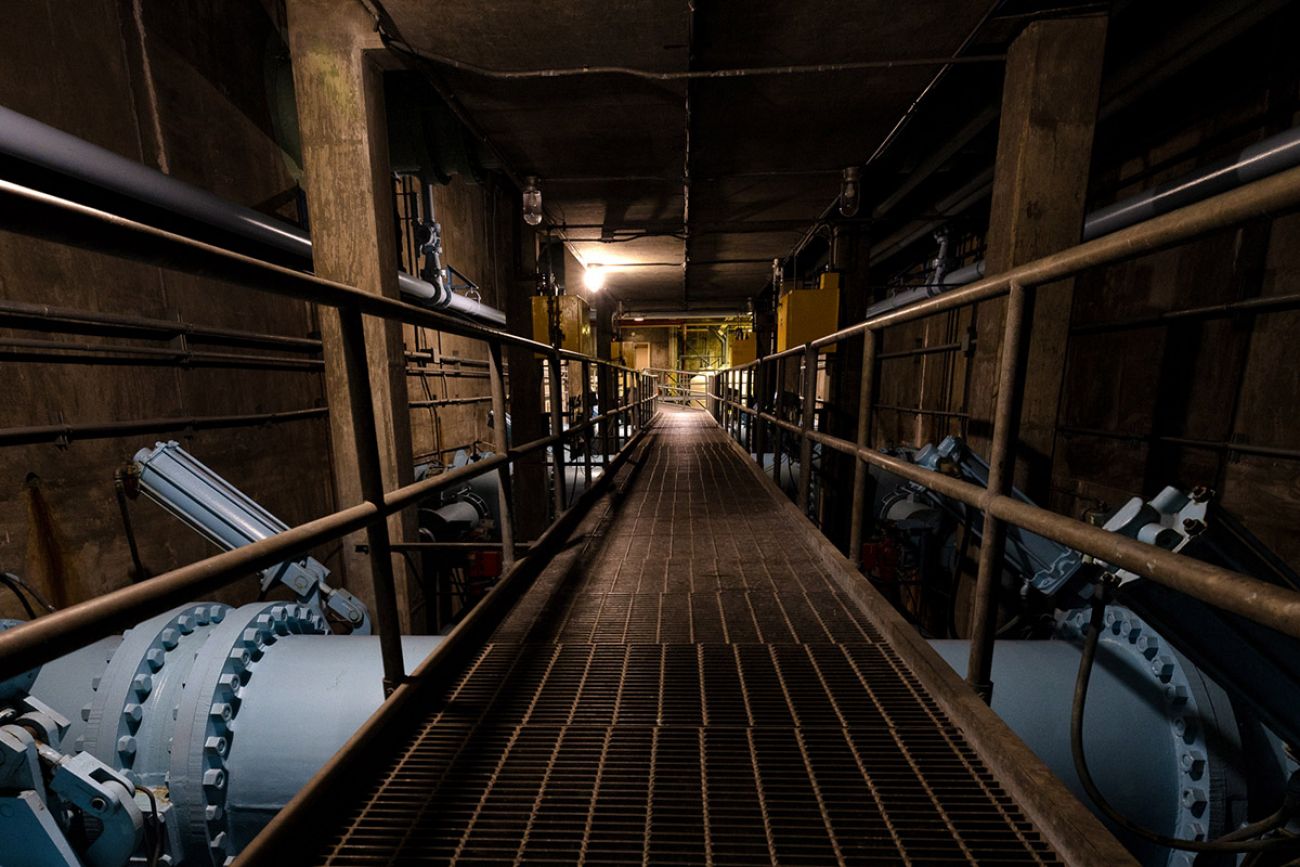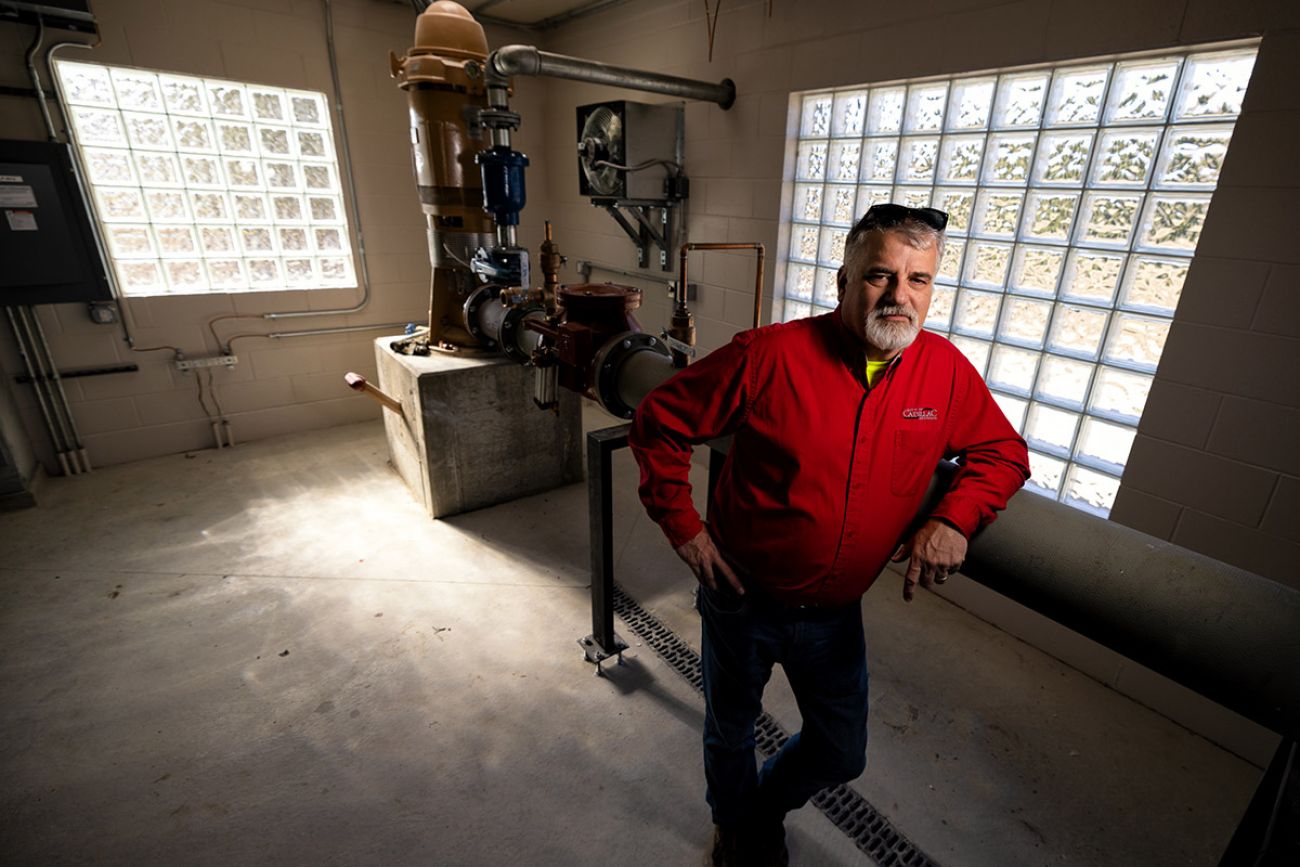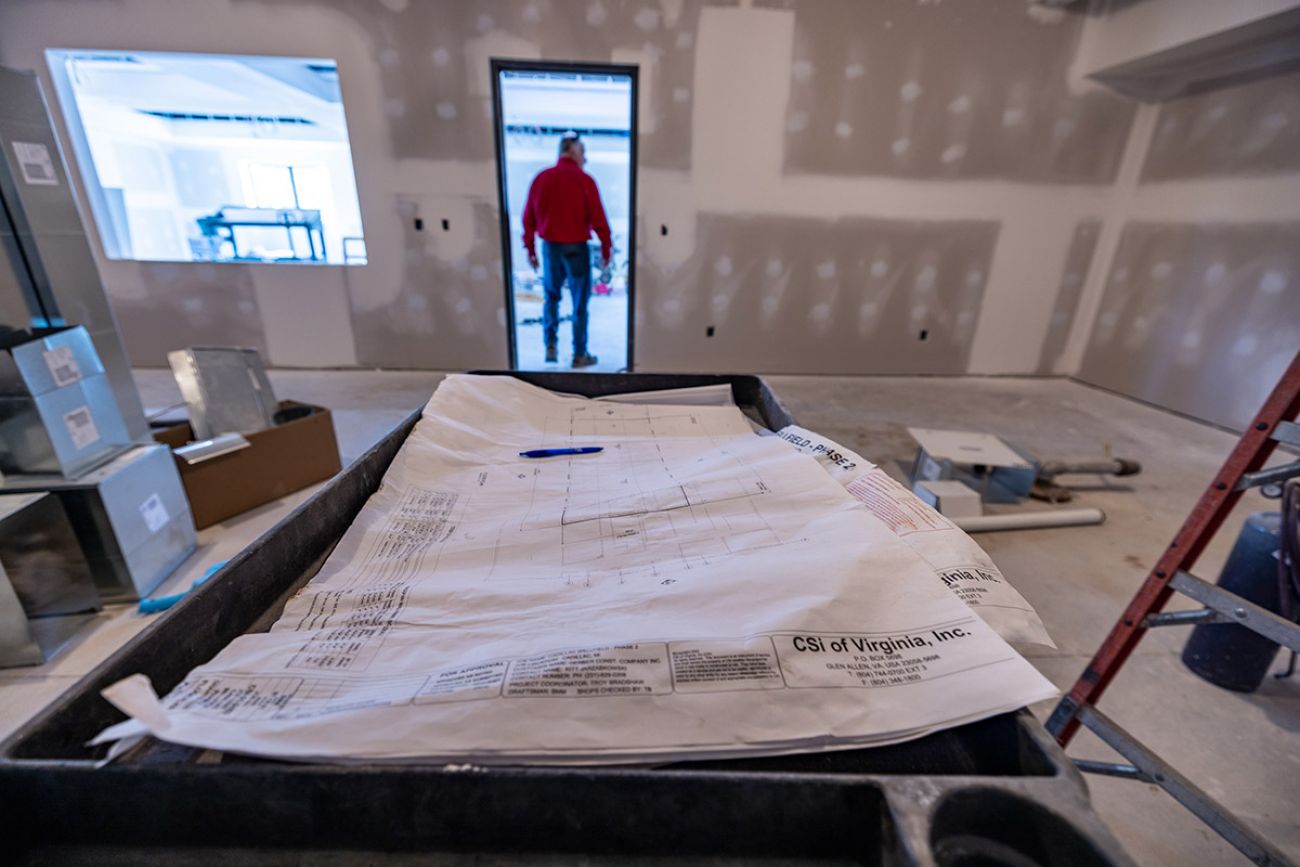Feds’ $1 billion allows Michigan to renew water infrastructure affordably

In a 15-year career, Kelly Green has worked at the junction of finance and infrastructure, helping to convert state and federal dollars to provide clean drinking water and keep sewage out of waterways.
Central to that work at the Michigan Department of Environment, Great Lakes, and Energy and its predecessor agency is a state-federal partnership to finance water infrastructure at affordable rates. Called the state revolving funds, the SRFs are now taking a starring role in renewing the nation’s water systems. They are the primary channel through which billions of dollars from the federal infrastructure bill will be directed to states and then to communities.
Water’s True Cost
Throughout the Great Lakes region and across the U.S., water systems are aging. In some communities, this means water bills that residents can’t afford or water that’s unsafe to drink. From shrinking cities and small towns to the comparatively thriving suburbs, the true cost of water has been deferred for decades. As the nation prepares to pour hundreds of billions of federal dollars into rescuing water systems, the Great Lakes News Collaborative investigates the true cost of water in Michigan. Read the rest of the series here.
As the administrator since 2018 of EGLE’s water infrastructure financing section, the unit that oversees the SRFs in Michigan, Green is in a position to guide decisions that will influence the quality of the state’s water systems as communities look to reverse the decades-long decline in fundamental public works.
Related:
- Rising water rates hurt Michigan’s poorest residents
- Short-changing Michigan local governments tied to deteriorating water systems
- Failing septic systems among the headaches in Michigan’s most pristine lakes
- Michigan's 20th Century water systems too big for its shrinking city populations
- Many rural towns have neglected drinking water systems for decades
- Water woes loom for Michigan suburbs, towns after decades of disinvestment
- After decades of neglect, bill coming due for Michigan’s water infrastructure
Green calls the momentous increase in capital spending for water “a very big opportunity” that also required equally significant changes in how the agency considers and approves applications for grants. The deteriorated condition of the state’s water infrastructure was not helped at all by decades of administrative and legal impediments that constrained SRF grant approvals and hindered the ability of smaller, low-income communities to access the funds.
In a series of conversations with community members, engineers, utility staff, and legislative aides, Green and her colleagues learned that EGLE and its predecessor agency had been marketing the SRFs to communities as a “program of last resort,” she said. EGLE made it clear that community water system managers should look elsewhere for financing. They were directed to approach the state for SRF loans if other options fell through.
It became clear that Michigan’s management of the vital funding program required a makeover.
“The biggest change that we made internally was basically a culture change,” Green said. “So instead of trying to find ways to say ‘No,’ we changed our culture and tried to find ways to say ‘Yes’ to communities and try to help them get into the program.”
The culture change came just in time. The Infrastructure Investment and Jobs Act, approved by Congress and signed by President Biden last November, provides roughly $50 billion over five years for water and sewer systems, the largest federal infusion in the sector in a half century. More than $43 billion of that total will flow through the SRFs, a move that propels the water account into the spotlight in every state.
Michigan is set to receive more than $1 billion over the next five years, significantly boosting the state’s lending capacity. The federal funds are an opportunity to reinvest in essential public works without saddling residents with all of the costs.
All told, it is a make-or-break moment for the SRFs. The next few years are a chance to accelerate work on removing lead service lines, stanching sewage overflows into rivers and lakes, and fixing some of Michigan’s most entrenched water problems. The relative windfall will assist with capital improvements even as utilities and state agencies must contend with rising project costs and staffing limitations due to inflation and labor shortages.
More Demand Than Dollars
Stalwarts of federal infrastructure financing, the SRFs have been the primary vehicle for federal funding of water and sewer systems since the Reagan administration, when grant programs for sewage treatment facilities were phased out in favor of low-interest loans. Congress established the Clean Water SRF in 1987. The Drinking Water SRF followed in 1996.
The SRFs are called revolving funds because loan and interest repayments return to the fund to be loaned out once again. Over more than three decades, the SRFs have received reliable congressional support: a total of $48.1 billion for the clean water fund and $23.6 billion for drinking water. Those dollars have been leveraged with state contributions (a required 20 percent match) and other funding sources to finance more than $202 billion nationwide in water system improvements. Michigan has financed just under $7 billion in SRF projects since 1988.
Green said the federal infrastructure bill is a welcomed opportunity to address decades of neglect. But spread across the state, the outlay is hardly enough compared to the extensive need in Michigan for sewers that do not spill human waste into rivers and water mains that do not rupture in freezing temperatures.
“I think that it's somewhat of a drop in the bucket, which is hard to say when you're thinking of it in large dollars,” Green said about the federal infrastructure funds. “But the needs are out there are very great.”
There is more demand for SRF dollars in Michigan than EGLE can supply. Last year was the first year that Green remembers not having enough funding for all the projects that applied. She attributes the upwelling of demand to the Flint crisis, which made water infrastructure a headline issue, and to the state’s strict lead and copper rule, which requires all lead service lines to be removed by 2045.
The supply-demand problem is not disappearing, either. The initial step in the SRF process is signaling an intent to apply. For fiscal year 2023, Michigan utilities indicated interest in $1.1 billion from both the drinking water fund and $1.7 billion from the clean water fund. Even with the influx of federal dollars, Green said that the agency can only fulfill a fraction of the requests. For the clean water fund, it has $881 million to distribute. The number of utilities that file formal applications, due this summer, will determine how many projects can be funded. But for drinking water, only $256.5 million is available. Many communities will certainly have to look elsewhere.
“That's a huge chunk of projects that are still getting left out of the revolving fund program,” Green said.
Impassable Process
Historically, Michigan has not spread its SRF loans widely. A report from the University of Michigan and the Environmental Policy Innovation Center examined SRF distributions by state between 2011 and 2020. The report placed Michigan last nationally in the percentage of water systems that had received an SRF loan.
Sara Hughes, one of the report authors and an assistant professor at the University of Michigan, said that the state’s bottom ranking reflects a strategy of awarding a smaller number of larger grants -- which generally go to larger utilities. Bringing smaller systems into the mix, she said, will require a shift in approach.
“I think it'll be a lift for a lot of states, but especially in a state like Michigan, where we have traditionally channeled larger funds to fewer systems, there's going to have to be a different decision-making system in place,” Hughes said.
Notably, the infrastructure law stipulates that 49 percent of the funds must be distributed to “disadvantaged communities” in the form of grants or forgivable loans -- an even sweeter deal for these places because they would not have to repay the money. Disadvantaged communities are the high-poverty areas that in the past have not had steady access to SRF financing and whose hobbled water and sewer systems could use a discounted makeover.
Change in Approach
EGLE hopes to accomplish that pivot with other adjustments that were identified during the community conversations that began six years ago. The department needs legislative approval for these changes because they are written in state law.
One adjustment aims to cut down on paperwork. Typically when communities apply for an SRF loan they are required to submit an extensive document called a project plan. The plan outlines 20-year infrastructure needs, project alternatives, technical reviews, and engineering analysis. Some of this material might be included in other documents but the only way to apply for an SRF loan is to pull it together in a project plan. To submit it to the state, communities have to hire a consulting engineer, a licensed professional who can charge $10,000 to $50,000 for the service.
“That's a lot of not only upfront cost, but it's a lot of work for the community to even go out and solicit an engineer to put that document together for them,” Green said. “So that really wasn't working for the community either.”
Though engineering firms are not cheap, Owen Roberts, the finance director for Cadillac, said that their expertise was “invaluable” in helping the northwest Michigan community with its SRF application last year.
EGLE is now asking the Legislature to approve procedural changes that would allow communities to access the SRFs without having to submit a project plan. Other planning documents would be accepted instead. The change is included in a series of three bipartisan bills that were introduced in March in the House of Representatives. Green called the proposed changes a “win-win situation for everybody.”
The other important adjustment is to the evaluation process. Like a teacher grading student essays, EGLE “scores” the SRF applications based on a rubric. A community already violating drinking water standards gets more points than one proposing a project to maintain its good standing. A larger community receives more points than a smaller community. Having a plan to protect your source water from contamination earns you points. Once the points from these and other categories are added up, projects with higher scores get funded.
The process works until it doesn’t. Replacing lead service lines, for instance, is a top priority for the state, which wants all lines removed by 2045, and for the federal government, which allocated $15 billion nationally in the infrastructure bill to the task. But under the current criteria, Green said that a community applying for funds only to replace lead lines would score very low.
“So a lot of these small communities that are doing lead service and replacement work only, don't rank high enough, right now, for us to even get money to them,” Green explained. It’s a problem the proposed legislation would allow EGLE to address.
If the Legislature acts on the bills this year, Green said that 2024 would be the earliest in which the new rules could be applied to SRF funding. A provision in the bills would allow EGLE to update the criteria itself, to reflect changing needs and priorities. Another provision would authorize EGLE to set lower interest rates for disadvantaged communities, a benefit that the U.S. Department of Agriculture already provides for its rural water infrastructure loan program.
Expanding Access
New support structures are being erected at EGLE to take advantage of federal dollars. The infrastructure bill allows the state environment agency to use 2 percent of the funds for public outreach. Smaller communities may be more familiar with the grant and loan program operated by the USDA, which caters to rural areas.
Outside of government, the Michigan Municipal League Foundation developed a toolkit for assisting disadvantaged communities in applying for federal infrastructure funds. These communities often are unfamiliar with the paperwork requirements or do not have the staff expertise to hunt down and apply for grants. They might not know how to comply with federal rules, such as those mandating American-made materials for construction. The toolkit was underwritten in part by the Charles Stewart Mott Foundation, which also funded the Water’s True Cost reporting project.
The administrative work taking place in Lansing might seem arcane. But it is intended to have real-world impact. The experience in Cadillac, a city of 10,400 people in Wexford County, illustrates the possibilities.

For years, the city supplied its drinking water from a well field on 8th Street. The field, however, was surrounded by a Superfund toxic waste site. In 1993, the industrial solvent TCE was found in one of the seven 8th Street wells. Cadillac incrementally began shifting its drinking water supply to areas not threatened by automotive degreasers leaking from Kysor Corporation’s waste lagoons.
To completely cut ties with 8th Street, the city needed new well sites. Cadillac’s finance director, Owen Roberts, searched for a low-cost loan to complete the work. Weighing his options, Roberts knew where to look. A decade ago Cadillac received a low-interest SRF loan to build a new well field at Crosby Road.
Last year, Roberts again applied for SRF financing, this time to build three wells at East 44 Road, plus a transmission main to connect the wells to Cadillac’s water distribution system. The project on the south side of town would complete the three-decade transition away from the compromised 8th Street site.

The application paid off. EGLE approved a 30-year, $9.8 million SRF loan for the East 44 Road project. Thanks to a 2.125 percent interest rate, an average water bill in the city is expected to increase by only $2 per month. Cadillac residents benefit not only from the low interest rate but the duration of the loan as well, Roberts said. A commercial loan would charge an interest rate two or three times higher. A tax bond wouldn’t extend payments over three decades.
Construction is expected to be completed in August or September, though that depends on supply chains and inflation, Roberts said. The timeline has already been pushed back three months.
Roberts would prefer not to borrow money for the well field. But if a loan is the only option, then the SRF, for Cadillac and many places like it, is the best choice available. “This is a good one,” he said about the program. “Absolutely.”
Michigan Environment Watch
Michigan Environment Watch examines how public policy, industry, and other factors interact with the state’s trove of natural resources.
- See full coverage
- Subscribe
- Share tips and questions with Bridge environment reporter Kelly House
Michigan Environment Watch is made possible by generous financial support from:
Our generous Environment Watch underwriters encourage Bridge Michigan readers to also support civic journalism by becoming Bridge members. Please consider joining today.
See what new members are saying about why they donated to Bridge Michigan:
- “In order for this information to be accurate and unbiased it must be underwritten by its readers, not by special interests.” - Larry S.
- “Not many other media sources report on the topics Bridge does.” - Susan B.
- “Your journalism is outstanding and rare these days.” - Mark S.
If you want to ensure the future of nonpartisan, nonprofit Michigan journalism, please become a member today. You, too, will be asked why you donated and maybe we'll feature your quote next time!






